Artists' Books
Artists' Books
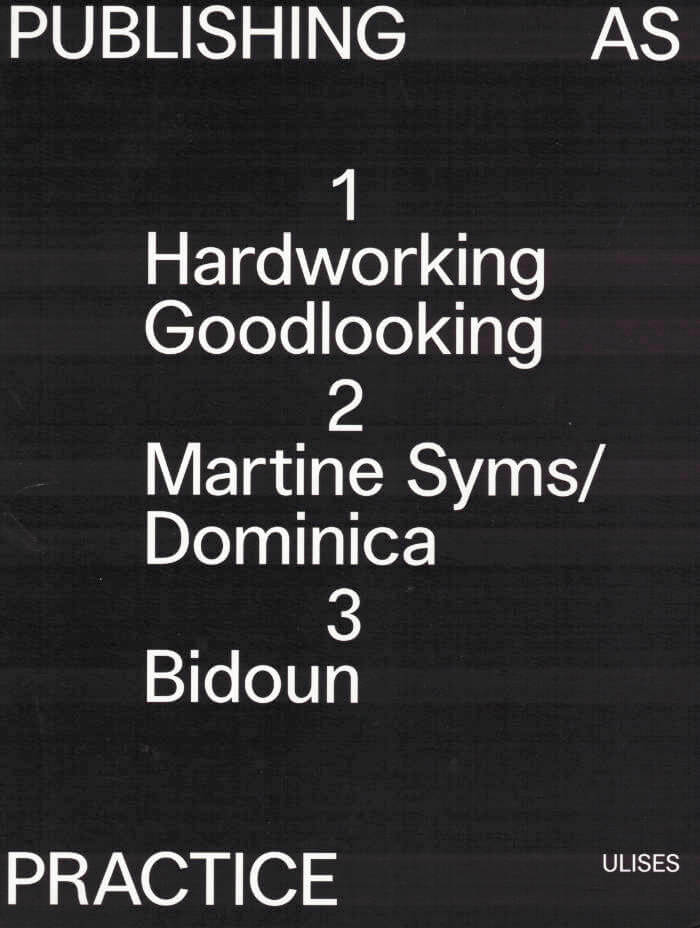
Publishing as Practice
Publishing as Practice centers on the work of three contemporary artists/book publishers who have developed fresh ways of broaching the political in publishing.
This book documents a residency program at Ulises—a curatorial platform based in Philadelphia—that explores publishing as an incubator for new forms of editorial, curatorial and artistic practice. Over the course of two years, three participants (Hardworking Goodlooking, Martine Syms/Dominica, and Bidoun) activated Ulises as an exhibition space and public programming hub, engaging the public through workshops, discussions, and projects.
Hardworking Goodlooking is a design and publishing imprint working primarily out of the Philippines. Dominica is an imprint run by artist Martine Syms dedicated to exploring Blackness as a topic, reference, marker, and audience in visual culture. Bidoun, a non-profit organization and magazine, focuses on art and culture from the Middle East and its diasporas. Each organization approached their residency at Ulises in a unique way, bringing a new understanding of what it means to practice publishing.
Edited by Kayla Romberger, Gee Wesley, Nerissa Cooney, Lauren Downing, and Ricky Yanas, Publishing as Practice features a preface by David Senior, Head of Library and Archives at the San Francisco Museum of Modern Art, and Ulises Carrión’s 1975 publishing manifesto “The New Art of Making Books.” Publishing as Practice also includes writing from Clara Balaguer, Hardworking Goodlooking, Martine Syms/Dominica, Bidoun, Lauren Downing, Kayla Romberger, and Gee Wesley alongside interviews, excerpts, and documentation from each residency.

Reading Room: An Experiment in Expanded Reading
“Reading Room: meeting the universe halfway is a book – a collection of five booklets – that came out of a multi-sensory project created by Harriet Plewis that attempted to make sense of a key text by theoretical physicist and feminist theorist Karen Barad.
The volume contains a booklet describing the ideas, experiments and practices of expanded reading in reference to Barad’s text, and the remaining four booklets are workbooks, or manuals, to help people replicate or expand on the ideas themselves. The books were produced by the artist in collaboration with Sam Whetton and Chery Styles.”
5x A5 booklets, All black & white digitally printed, 4x saddle stitched 1x perfect bound. Comes sandwiched between embossed card.

Saliva
Marine Forestier, Kamilé Krasauskaité and 1 more
Saliva est le résultat d'une résidence collaborative en octobre 2021 à Fructôse, Dunkerque.
Édition de 100 exemplaires.

WILL YOU MARRY ME?
The ultimate ambition of this book-tool is to “disappear on the street”. Its pages collect words and stories of people whose right to exist and be visible in public spaces was forced to confront the concepts of “legality” and “justice”.
Considering the assumption that the law is a fluid parameter, which changes depending on where we are in the world, the historical period in which we live and the sort of privileges we enjoy, the law defines what is considered moral, licit, in other words, what is right. It distributes power and the perception of power in society, defining, categorizing, dividing and controlling.
WILL YOU MARRY ME? is a public lecture and an artist’s book by Sara Leghissa and Marzia Dalfini, investigating a specific portion of the spectrum of illegality, namely the relationship between illegal acts and public space. It explores how we can act disobedience before everyone’s eyes, suggesting possible forms of complicity and public resistance.
All the content was collected by the artist during meetings and conversations that took place in Prato, Milan, Ramallah, Marseille, Madrid, Nyon and Lausanne and with this book-tool their words become manifestos that the reader is invited to detach and relocate into the public space.
Designed by Marzia Dalfini. Published by NERO with the support of L’Altra.
Format: 42 x 29,7 cm
Pages: 28
Language: IT / EN
Year: 2021

Side Magazine #01 – The Professor
The first issue of the editorial discursive space for the Bergen Assembly triennial, conceived by Saâdane Afif, explores the identity, role and position of the Professor.
Side Magazine is conceived as a site of research for the fourth edition of Bergen Assembly convened by Saâdane Afif. Yasmine d'O., who has been invited as curator of the upcoming edition, will be the executive editor.
Side Magazine is dedicated to the seven characters in The Heptahedron, a play written by the French poet, essayist, and scholar Thomas Clerc in 2016. In order of apparition these characters are the Professor, the Moped Rider, the Bonimenteur, the Fortune Teller, an Acrobats, the Coalman, and the Tourist.
The first issue of Side Magazine is dedicated to the figure of the Professor. It features seven articles, each of which explores the identity, role, and position of the Professor. Contributors include Uli Aigner, Lili Reynaud-Dewar, Jörg Heiser, Christian Nyampeta, Marjorie Senechal, and Vivian Slee.
Seven issues of Side Magazine will be released in the run up to the opening of Bergen Assembly 2022, opening September 8. A special eighth issue will be published after the opening days. This, combined with the existing seven issues as a collection, constitute the exhibition catalogue and guide.
Saâdane Afif (born 1970 in Vendôme, France) creates installations made up of unexpected encounters between objects. These creations, of uncertain status, oscillate between function and symbol, between art and design, and provoke shifts of meaning that engage a reflection on today's industrial society.
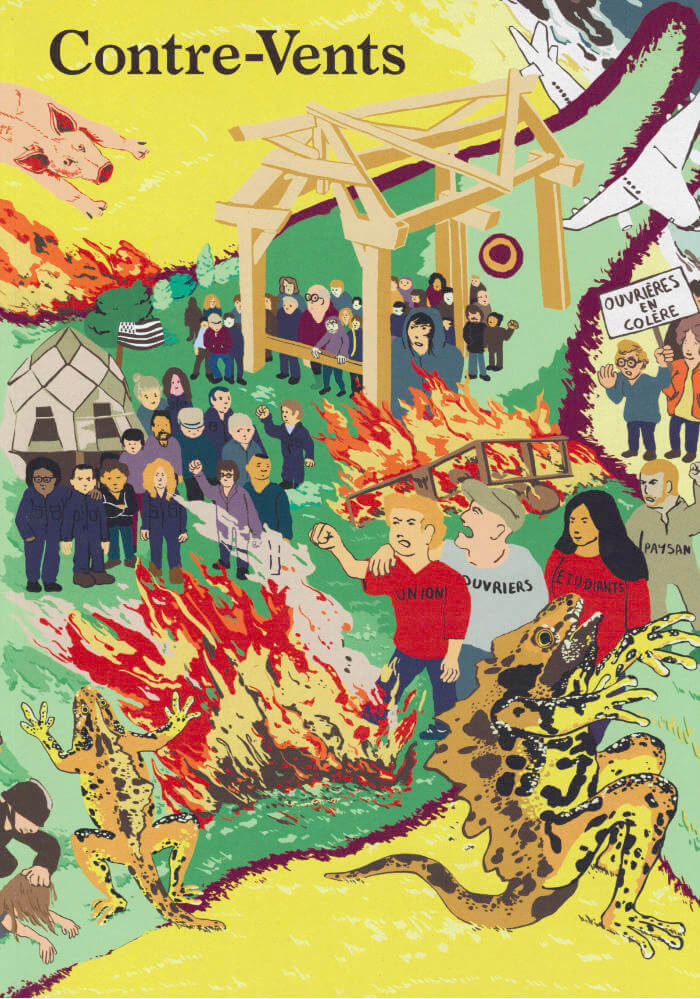
Contre-vents – Colères, espoirs, écologies et politiques dans l'Ouest de la France
François Piron, Guillaume Désanges
A documentary and speculative publication on a genealogy of political, social, ecological and identity-based struggles in the Brittany region and the West of France, from the 1960s to the Zone to Defend of today, based on numerous documents and films made by filmmakers and collectives.
Published following the eponymous exhibition at Grand Café, Saint-Nazaire, in 2019.
Texts by Isabelle Cambourakis, Jade Lindgaard, Élise Roullaud; interviews with Jean-Louis Le Tacon, Patrick Prado, Joseph Potiron, Olivier Tric.
Graphic design: Laure Giletti & Grégory Dapra.
published in September 2021

Diaries and Dreams – 1976-1979
Second volume of Ion Grigorescu's translated diaries, assembled like a small literary and art-historical sensation of the period between 1976 and 1979.
In recent years, the work of Ion Grigorescu, one of the seminal Eastern European visual artists of his generation, has attracted increasing attention in the West. This volume is the second of his translated diaries—the first from 1970 to 1975 was published in 2014 by Sternberg Press—and is assembled like a small literary and art-historical sensation of the period between 1976 and 1979. It not only counters the facile reading of Grigorescu's practice in the context of Conceptual art and performance art, but provides insight into the artist's multifocal thinking, which incorporates an original critique of modernism, the dystopian effects of an instrumentalized idea of reason and rationality, an analysis of subjectivity, and a penetrating gaze into a dialectic of secrecy and elucidation, of exposure and mystification.
Grigorescu's diaries are written notes revolving around the status of the image and investigate the relation of the body to society and of art to the world through a phenomenological approach. His work proposes a parallel conception of the public made tangible through the eloquence of the body.
In poetic language full of powerfully pictorial metaphors, Grigorescu's reflects on the tension between the realistic effects of the image, the suppression of realism, and the hidden traces the gaze holds through the activities of the increasingly present unconscious of collective memory. Along with the drawings, paintings, photographs, and sketches that accompany them, the diaries serve as an introduction that open the possibility of conceiving Grigorescu's art as a rare evocation of a singular way of thinking: a stance.
Ion Grigorescu (born 1945, lives and works in Bucarest) is one of the most emblematic artistic personalities of the post-war period in Romania, a key figure of conceptual artin Eastern Europe.

Hooker's Green Lake
A series of recent drawings by London-based artist Faye Wei Wei.
Faye Wei Wei (born 1994) is a British artist. She has had solo shows at Project Room, Galerie Kandlhofer, Vienna (2020), Cob Gallery, London (2019), SADE Gallery, Los Angeles (2018), Centre For Chinese Contemporary Art, Manchester (2018)... She graduated from the Slade School of Fine Art in 2016. She lives and works in London.

Tense
Tense is a never-realised publication, written and composed by Lucy Lippard and Jerry Kearns in 1984, that only now has been released in a very limited run on our imprint. The book accompanied the exhibition Top Stories, which took a closer look at the 29 issues of the prose periodical with the same title, founded in the late 1970s by Anne Turyn. Top Stories was dedicated to fiction by emerging women artists and writers from that time. Tense was originally intended to become part of the series as well, but never made it to print. It was only recently – during the making of the exhibition at Amsterdam’s Kunstverein – that the original mock-up was retrieved from the editor’s archives and finally sent off to the printer.
40 p, ills colour & bw, 13 x 21 cm, pb, English
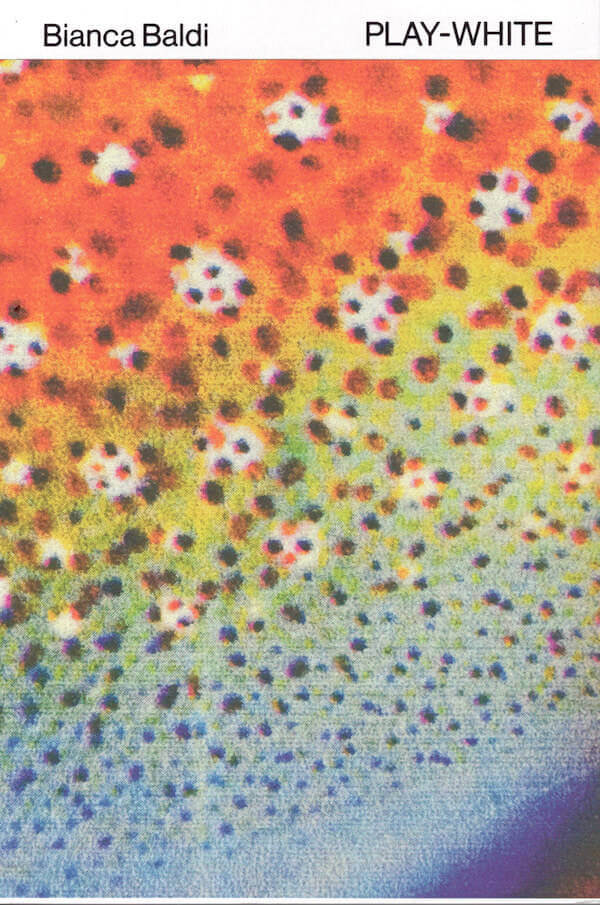
Play-White
The racist term "play-white" comes from the apartheid era, when it connoted a black or mixed race person who lived as a white person: “So and so is a play-white.” South African artist Bianca Baldi draws from studies of biomimicry and her own family history, as well as literary precedents—such as Nella Larsen’s novel Passing (1929)—to reflect on racial passing and the instability of racial identities. Play-White alternates between layers of visualization and moments of discretion in order to explore questions of presence and evasion beyond their representation in black and white.
With contributions by Bianca Baldi, Mika Conradie, Shoniqua Roach, Amy Watson, and others; design by Katharina Tauer & Wolfgang Hückel in collaboration with K. Verlag.
Published 2021

Short Term Eternity
Anu Vahtra, Gordon Matta-Clark
"Short Term Eternity" brings together two artists – Gordon Matta-Clark (1943–1978, USA) and Anu Vahtra (1982, Estonia) – whose practices are related to each other in many ways, even if they are born in different times and locations. The aim of the book is not just to compare their work, but to describe the circling of ideas and strategies in the art world from a non-hierarchical perspective.
The book is published on the occasion of "Gordon Matta-Clark: Anarchitect. Anu Vahtra: Completion through removal", an exhibition in the Kumu Art Museum in Tallinn, February 22 – June 8, 2019, organised in cooperation between the Bronx Museum of the Arts and the Kumu Art Museum, curated by Sergio Bessa, Jessamyn Fiore, and Anu Allas.
As a contrast to the large-scale installations in both Matta-Clark’s and Vahtra’s practice, the book is small in size. The content is printed on thin paper and is divided into three parts. It starts with Completion through removal, a series of photographs by Anu Vahtra showing the spatial intervention realised in the Great Hall in Kumu and ends with the illustrated script of Vahtra’s performance piece Open House Closing. A Walk. The middle section of the book includes three thoroughly illustrated essays, where the images are printed overleaf from the text and are only visible through the page in a gap in the text at their intended location. These gaps or cuts in the text refer to the empty space, characteristic for the practices of both Matta-Clark and Vahtra.

Atlas Europe Square
Atlas Europe Square documents a body of work by Swiss artist Yves Mettler who, since 2003, has engaged in an ongoing mapping and documentation of these sites, along with a series of projects triangulating between particular squares, interrogating their differing architectural, environmental, and public functions, and what they tell us about the ideality of ‘Europe’ and the (im)possibility of its concrete instantiation.
Here this work is extended into reflections on the relationship between art and public space, site-specificity, and the artist’s own implication in the imaginary of Europe as he becomes enmeshed in a network of projects, funds, and public bodies that seek to promote ‘European culture’ through art.
With contributions by Reza Negarestani, Laurent Thévenot, Teresa Pullano, Stephen Zepke, Neil Brenner.
Published September 2021

Draconis Lacrimae: Escape From The Guts of The Dragon
Federico Vladimir Strate Pezdirc, Pablo Esbert Lilienfeld
In this Player’s Handbook you’ll find the rules of a Fantasy Role Playing Game: Draconis Lacrimae. It can be played by a group of 3 to 6 players.
First, you will create the Characters, then you will create the World and, lastly, you will Role-Play to escape from the inside of The Dragon. The characters come from different background universes and they all meet in The Dragon’s guts after being swallowed/injected/tele-transported/etc. by their own dragons. In Draconis Lacrimæ there are no dungeons and dragons, the dungeon is the Dragon. The adventurers must join forces in order to “escape” from it, whatever escape might mean.
This game is an invitation for the readers to play themselves otherwise and encounter otherness as an accomplice. In addressing certain construction paradigms of the self, the book invites the reader/player to welcome the alterity we have in us, in order to revisit fundamental archetypes of fiction. It aims at creating interstices that can open up to another view of the self and its social configurations.
Autobiography is used as a ground from which to start playing, as the material that one has at hand to transform, craft, dissolve, rebuild, paint, glitch, etc. Auto-fiction serves here as a tool to resist predefined categorizations of identity, as a technique of transformation and orientation in a world saturated with categories.
Hopefully, along the way, our fictional and real selves will start bleeding onto each other, the infinite threads of our possible selves hanging around us connected to our play partners, known and unknown.
“The Dragon is the figure that extends the couple, that expands the kin, that narrates the community. The Dragon is the shared collective fiction that appears within the mosh.”
The publication consists of two parts:
"Draconis Lacrimae. The Player’s Handbook” (A5, 160 pages), divided in three chapters: Character Building, World Building and Role-Playing.
“Draconis Lacrimae. After action report” (A5, 8 pages). A booklet that accompanies the book. An after action report contains the stories created during a game. This booklet is a draft of the fiction and characters created while playing Draconis Lacrimae.

Borrowing Positions
Borrowing Positions: Role-Playing Design & Architecture is a speculative book which reflects on the design- and architecture-centred LARPs (Live Action Role-Plays) organized by the Trojan Horse collective. The book is an exploration of Live Action Role-Play as a design and architecture research tool. By inviting the reader to try on different characters, switch roles and reconsider their everyday practices, the book explores issues such as identity, performativity, gender, colonialism, care responsibilities and fear in the context of architecture, design and urban planning.
The book consists of three parts: an overview of previous LARPs and their theoretical background; reflections (essays, visual essays and interviews) on LARP-related issues; and a practical (DIY) section – a step-by-step guide on how to organize your own design LARP.
Contributors to the book vary from architecture and design practitioners to performance artists working with role-play and fiction. The book will be of interest to anyone interested in inderdisciplinary practices in design and architecture.

Buch Livre Libro
The M-Budget book is a publication released on the occasion of the exhibition ‘Tisch Table Tavolo’ by Sophie Nys at Archiv in Zurich.

Alas
First published in 1759, Laurence Sterne’s ‘The Life and Opinions of Tristram Shandy’ is widely considered a revolutionary novel, and its style is marked by digression, double entendre, and graphic devices.
In ‘Alas, artist Sophie Nys obsesses about one of these devices, the so-called black page, famously paired with the line, “Alas, poor Yorick!” She compiles a remarkable collection of black pages, all gathered from more than 100 different editions of Sterne’s book.
Included is a text by Peter de Voogd, the collector and owner of the library from which all the images in this publication originate, on the technical challenges that printing a black page presented for these early editions.

Something Like A Phenomenon
First monograph of artist Sharon Van Overmeiren, published by Damien & The Love Guru (2021).
Sharon Van Overmeiren (°1985, Antwerp, Belgium) recently completed the Residency Programme in Jan Van Eyck Academie, a multiform institute for fine art, design and reflection in Maastricht. Her research focuses on the significance and the common lineage of objects displayed in various compositions, in particular the relationship and intersection between objects and their natural, metaphysical expression.
Book design by Hagen Verleger.
With a guiding soundtrack / usb card by Elko Blijweertd.
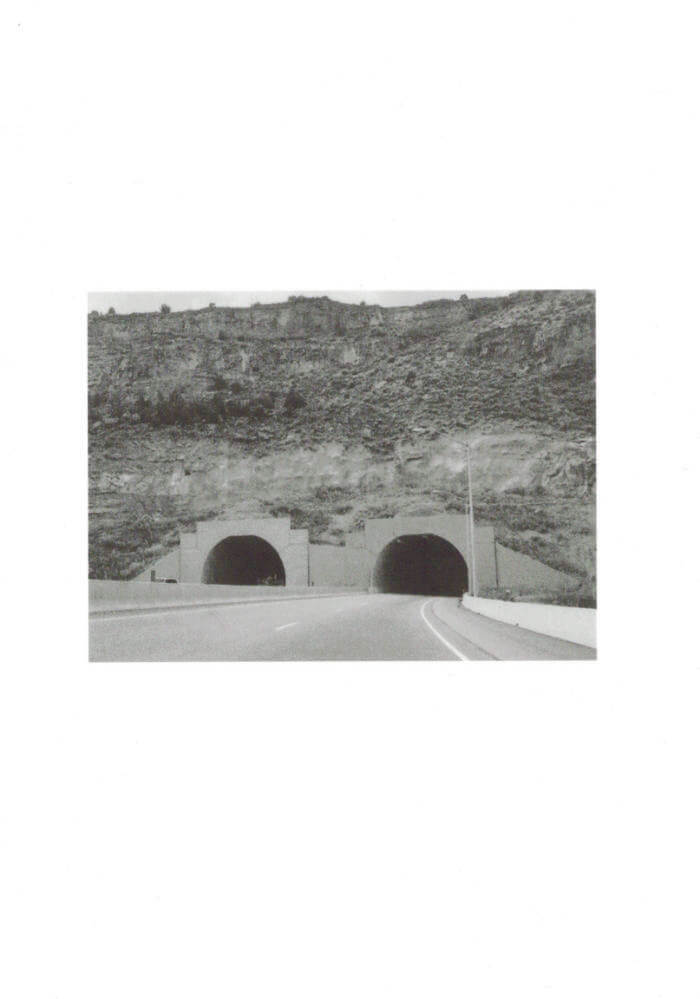
100+more
100+more is het resultaat van een beelden dialoog tussen Jelle Martens en Tim Bruggeman in het voorjaar van 2021. Beide verzamelden ze de voorbije jaren een uitgebreid digitaal archief met beelden van het internet, film stills, schermafbeeldingen, reproducties van kunstwerken en zelfgemaakte beelden. Deze publicatie brengt een selectie van 302 zwart-wit beelden samen vanuit een weloverwogen willekeurigheid.
100+more is the result of a visual dialogue between Jelle Martens and Tim Bruggeman in the spring of 2021. In recent years, both have collected an extensive digital archive with images from the internet, film stills, screenshots, reproductions of artworks and images they created themselves. This publication brings together a selection of 302 black-and-white images from a chosen randomness.
Offset
304 pages
Edition of 250
14 x 20 cm
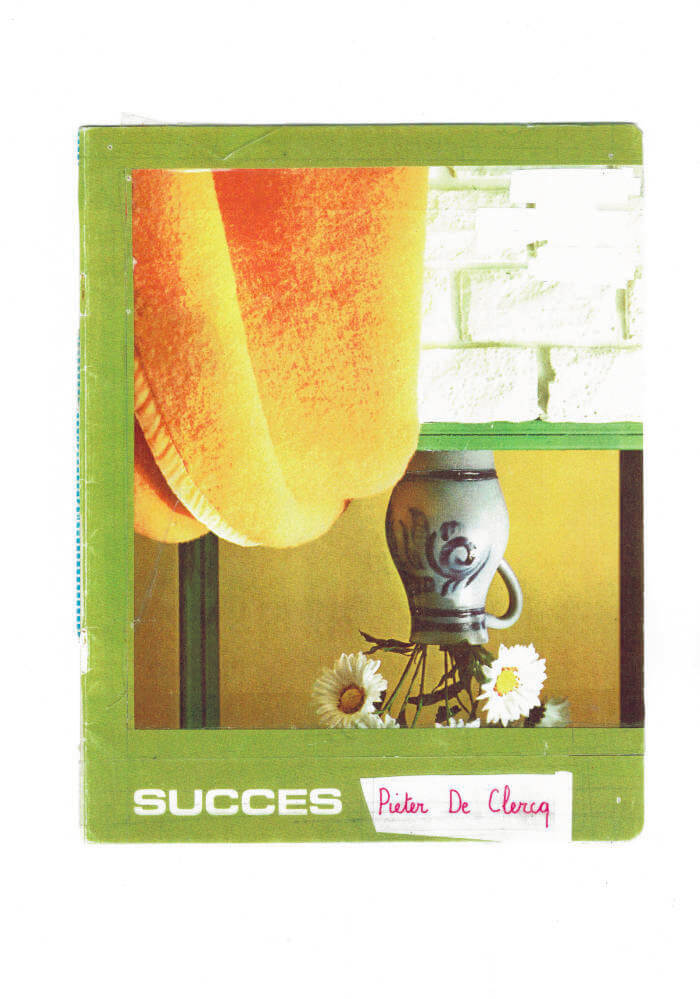
SUCCES
kunststof (20x) kunststof kunststof kunststof
kunststof kunststof kunststof kunststof
kunststof kunststof kunststof kunststof
kunststof kunststof kunststof kunststof
Kunststof
Digital print
104 pages
Edition of 50
21 x 29,7 cm
More images at https://infinitif.org/SUCCES

Where Do You Draw The Line Between Art and Politics
Where Do You Draw The Line Between Art and Politics? consists of a series of interviews with individuals who have been active in various capacities at the intersection of art and politics. Between historical documentation, political memory, dialogic reflections and motivational support, the publication focuses on the experiences, commitments, and feelings that animate and inform aesthetic priorities in social spaces both within and outside of art institutions; a repository designed to inspire and enourage the politicization of aesthetics, as opposed to the aestheticization of politics.
Davide Tidoni is an artist and researcher working with sound and listening. With a particular focus on direct experience, observation, and action, he creates works of different formats that include live performance, intervention, walk, video, audio recording, and text scores. He is interested in the use of sound and music in counter-culture and political struggles and has published a sound based field research on the northern italian ultras group Brescia 1911 (The Sound of Normalisation, 2018).

Lilith, Losing, Lavender
Lilith, Losing, Lavender: A love letter to love, is a publication based on stretching the subjectivities in love from the formulation I love You, as a way of seeing what is under the gaze of western romantic ideas and heteropatriarchal structures that may reveal problems in language about love.
It gathers a collection of texts written throughout the artistic research trajectory of Andrea Zavala Folache. With different narrative styles as diary, love letters, score instructions, this collection imbricates ideas of love, art and life as an essay about conditions of attachment.
In the interstice of several practices as dance, writing and drawing and different spaces as the dance studio, the atelier, the classroom, the theatre and the white cube, Andrea’s research focuses on non chronological dramaturgies for the emergence of surprise or unexpectedness.
Published 2021.
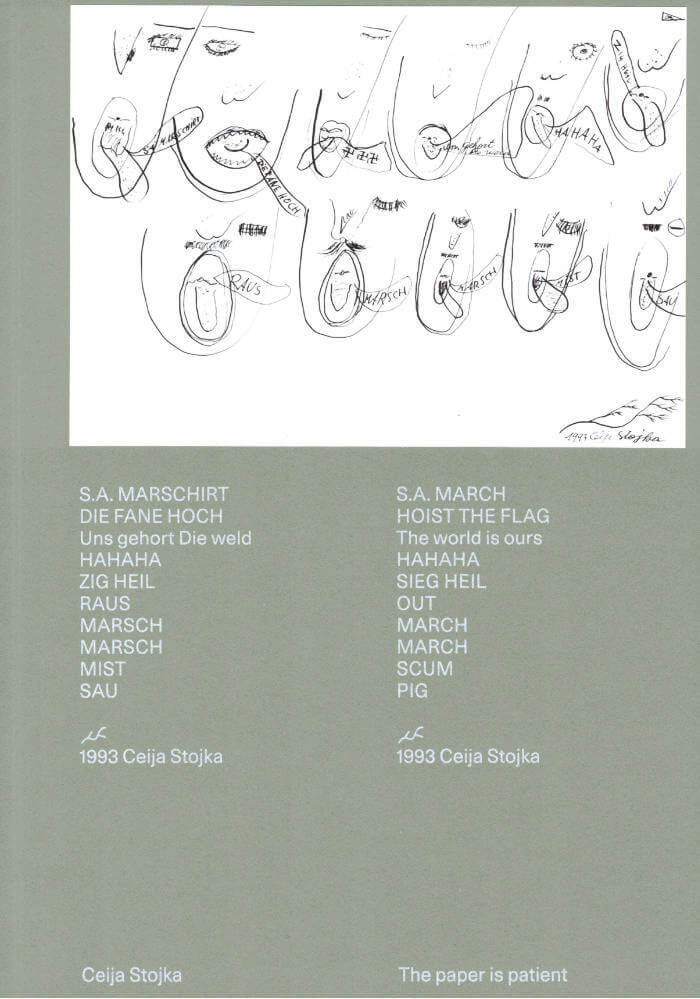
The Paper is Patient
The work of Ceija Stojka (1933-2013) is considered today an invaluable testimony on the deportation and the holocaust of the Romani people during the Second World War. For the very first time, this publication considers equal to her graphic work the notes she wrote on the back of her drawings and paintings. Stojka's particular use of language, phonetically adapted from her knowledge of German, is here transcribed and translated into English, while giving access to both sides of her works.
Published on the occasion of the eponymous exhibition at Malmö Konsthall in 2021.
Ceija Stojka was born in 1933 in Austria to a family of Romani horse traders, the Lovaras. She was still a child when the nazi racial laws drove her into the hell of the concentration camps for 24 months. As a survivor, she covered up this trauma with a heavy silence for almost 40 years. In the 1980s, facing other tragic circumstances in her life, the denial of the Romani holocaust and the resurgence of extreme right-wing racist ideas in Austria, she felt an urgent need to testify. She wrote at first, then started to draw and eventually found her way by blending the two as a self-taught artist. She calls upon us, through her visions of childhood, to never turn a blind eye on what happened, and to remain vigilant as to what may emerge again. Ceija Stojka died in 2013 in Vienna.
Edited by François Piron.
Texts by Ceija Stojka, Noëlig Le Roux, Irka Cederberg.
Graphic design: Coline Sunier & Charles Mazé.

I am Welton Santos.
I am Welton Santos reenacts a dialogue between the Brazilian geo-bio-architect Welton Santos and an Interviewer. The book, which is always read collectively, is used in reading performances by groups of at least 3 people.
Printed on the occasion of an artist residency at PAV, Parco d’Arte Vivente, Turin, July 2016. Texts based on transcripts of interviews with Welton Santos.
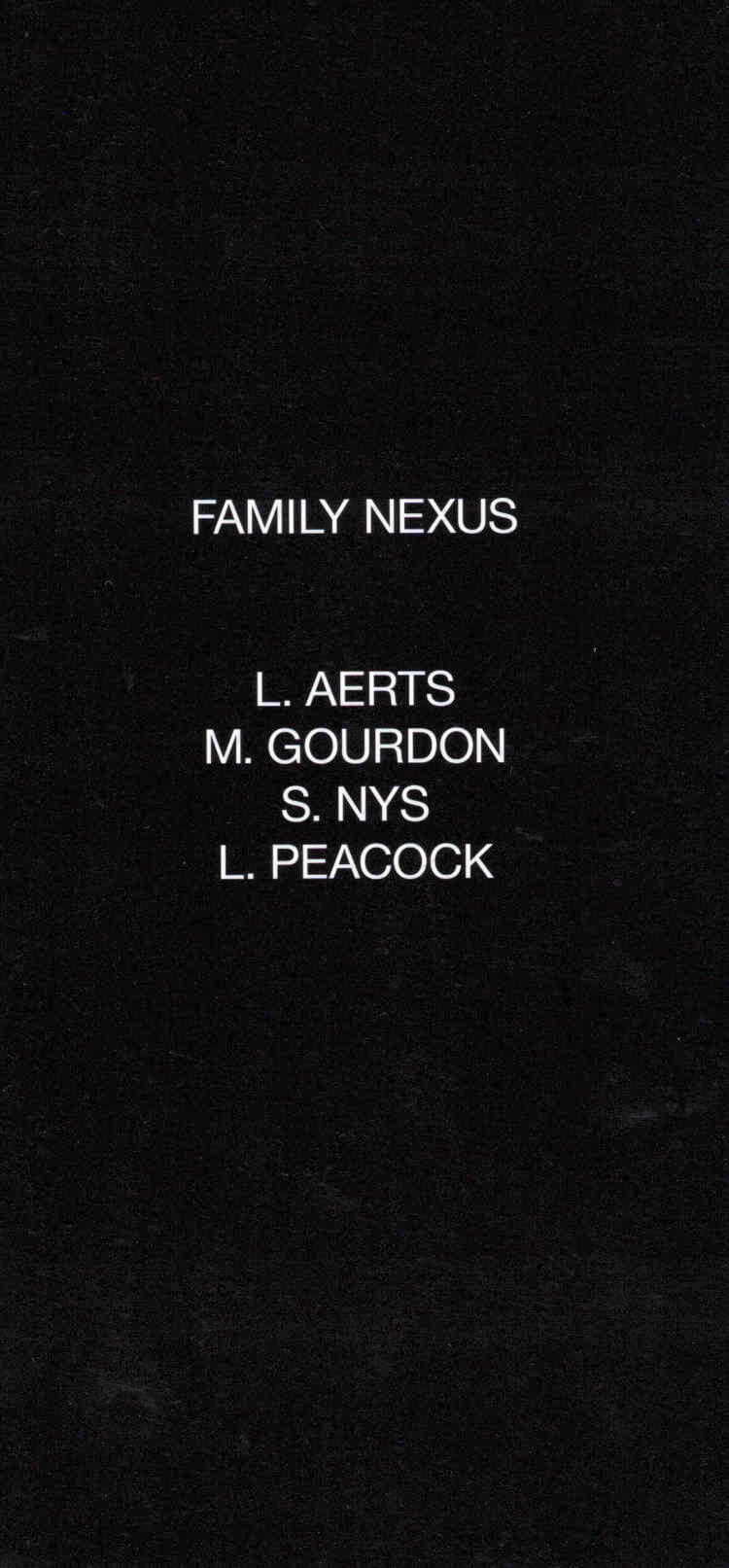
Family Nexus
Sophie Nys, Liene Aerts and 2 more
In April 2019, Sophie Nys presented the solo exhibition Family Nexus at KIOSK. In psychology, a family nexus stands for a vision that is shared by the majority of family members, often unconsciously and for several generations long, and is upheld in the context of events both within the family and in its relationship to the world. Among other, the monumental, stretched out net in the dome space was a symbol of this family dynamic.
Two years later, the theme is still working its way through the above mentioned heads. The shared interest of Nys, Gourdon, Aerts and Peacock leads to a collaboration in the form of a book that, just like the exhibition, can be read as a net of (un)coherent intrigues and knots in which no position can be neutral. They set up a network of characters. Together they represent all kinds of (human) connections. Family Nexus is a story about everyone and no one in particular. Who in this book is playing the role of the Nobody, the household’s so-called 'identified patient', or scapegoat, and which pots and pans has slipped through this character’s fingers?
Co-production: KIOSK and BOEKS.